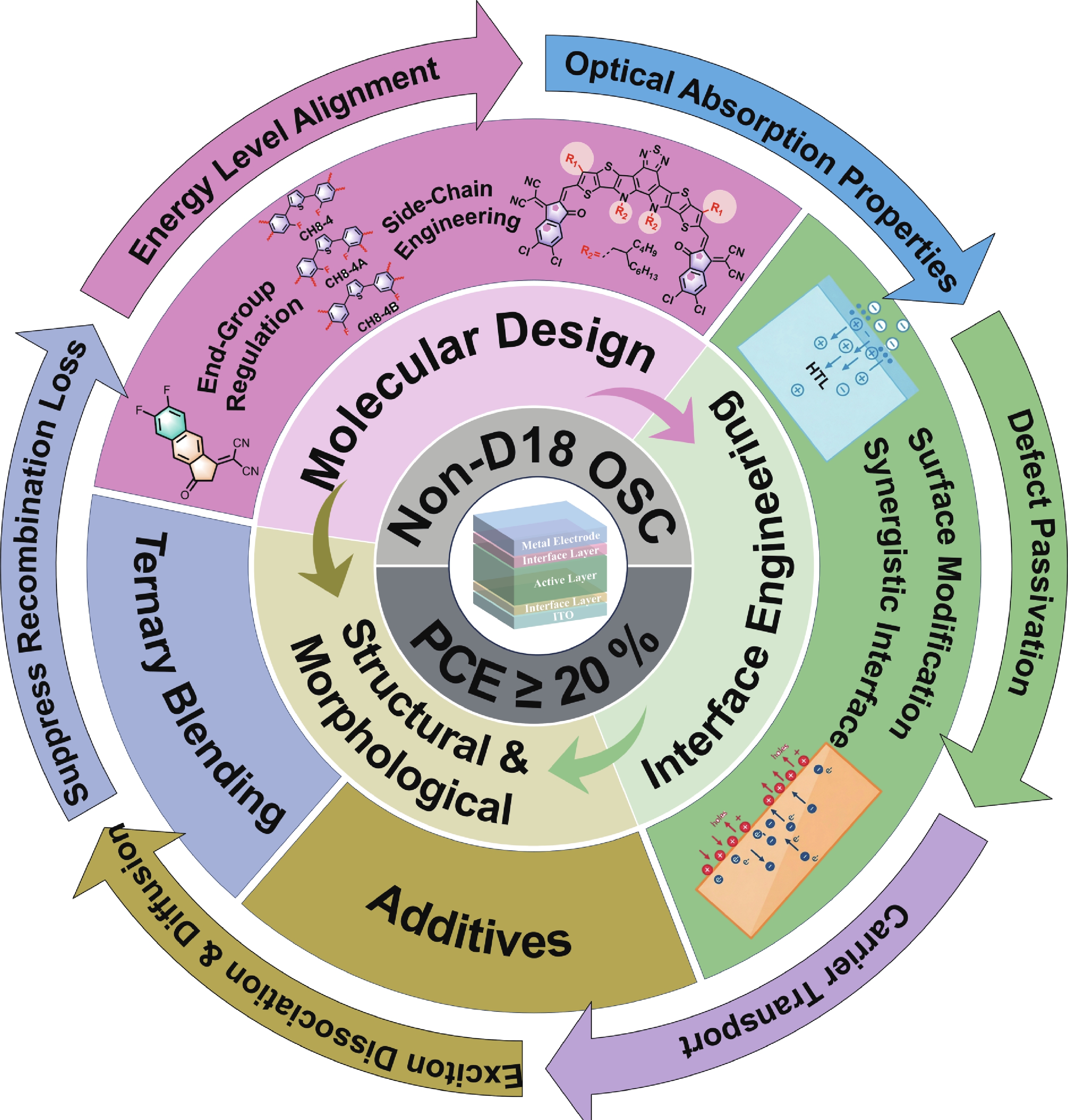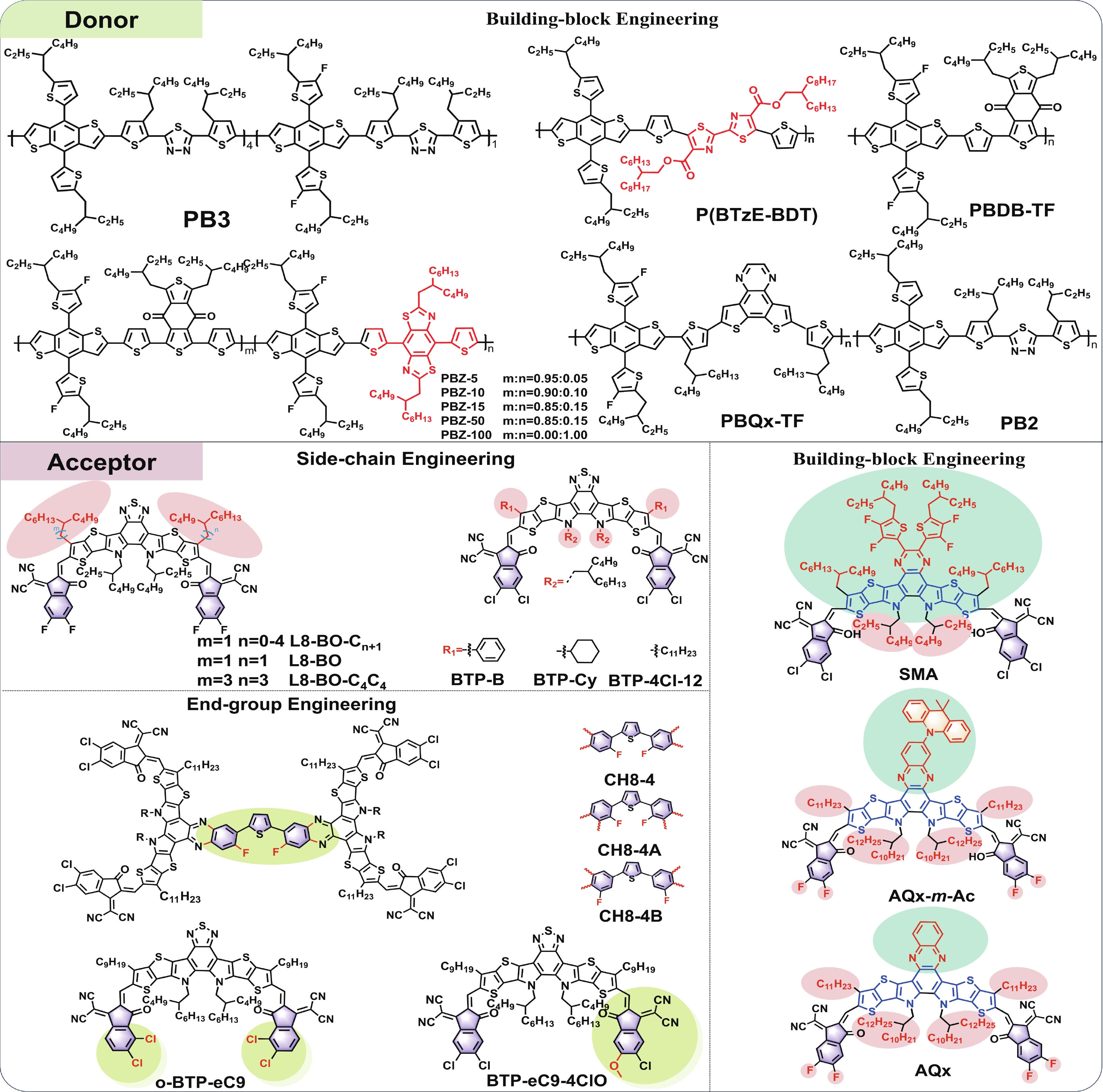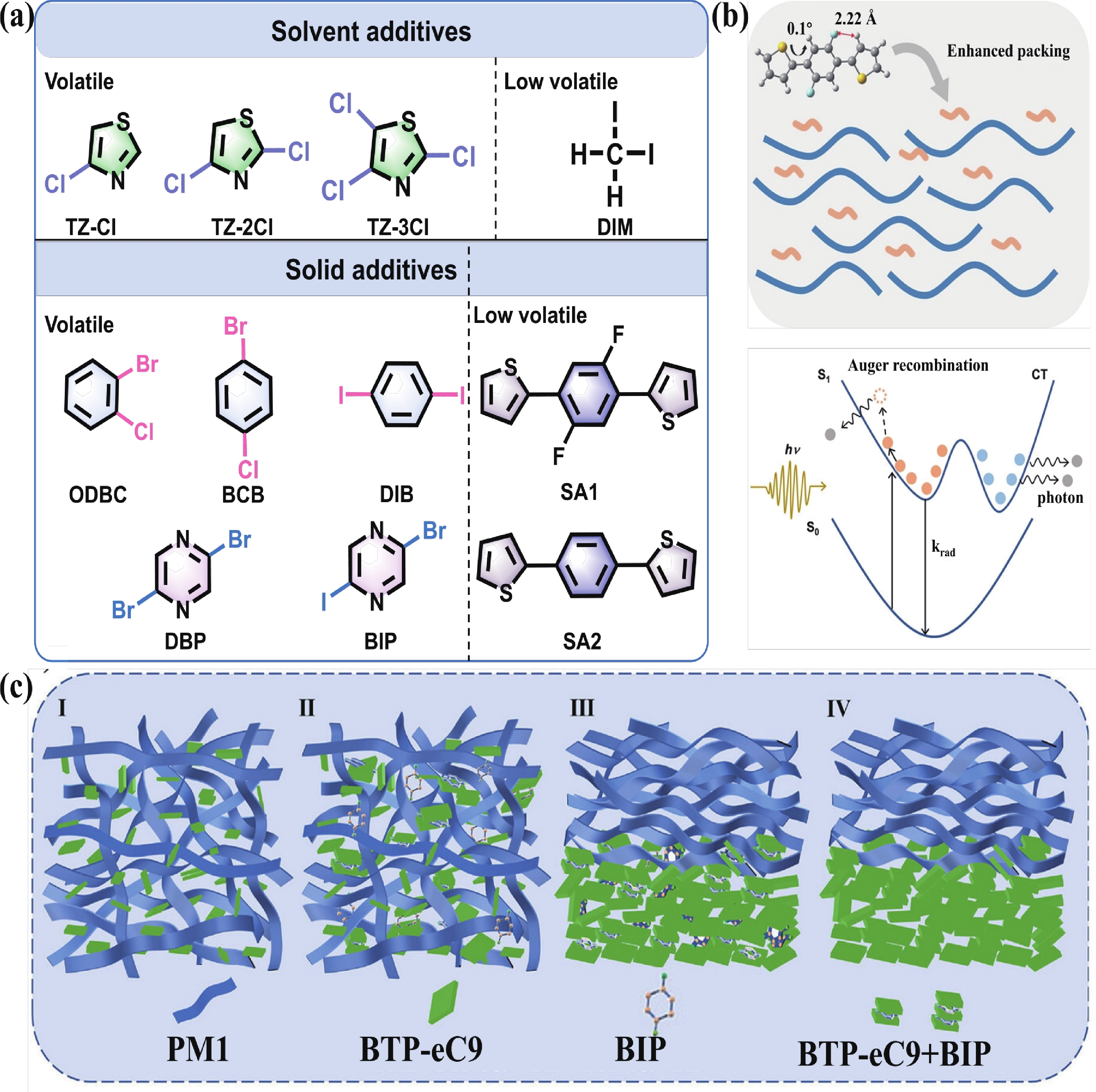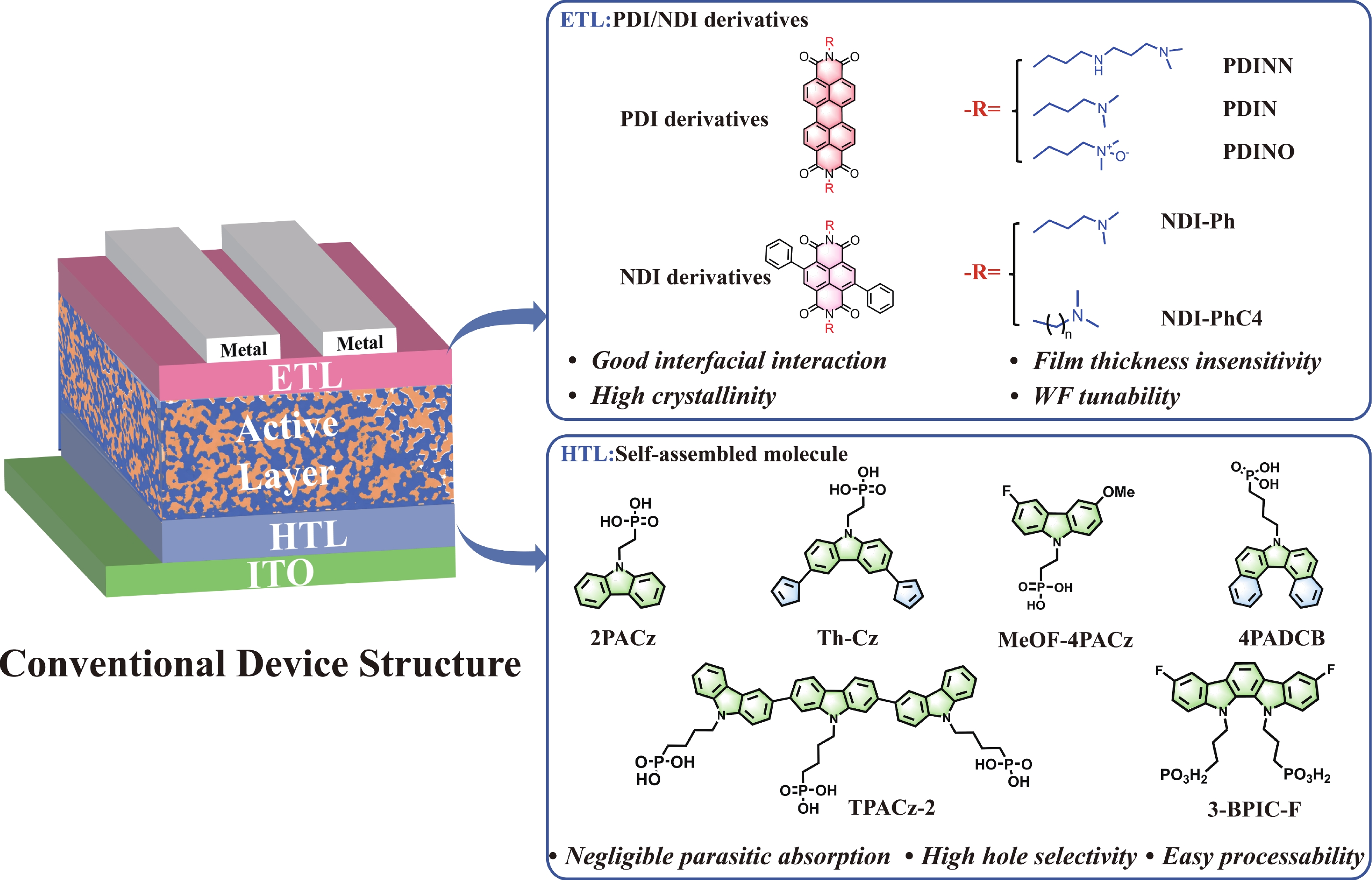| Citation: |
Fang Yang, Erming Feng, Chujun Zhang, Jianhui Chang, Hengyue Li, Fangyang Liu, Yingping Zou, Junliang Yang. Non-D18-based organic solar cells: strategies and insights toward the efficiency ≥ 20%[J]. Journal of Semiconductors, 2026, In Press. doi: 10.1088/1674-4926/25080035
****
F Yang, E M Feng, C J Zhang, J H Chang, H Y Li, F Y Liu, Y P Zou, and J L Yang, Non-D18-based organic solar cells: strategies and insights toward the efficiency ≥ 20%[J]. J. Semicond., 2026, 47(2), 021801 doi: 10.1088/1674-4926/25080035
|
Non-D18-based organic solar cells: strategies and insights toward the efficiency ≥ 20%
DOI: 10.1088/1674-4926/25080035
CSTR: 32376.14.1674-4926.25080035
More Information-
Abstract
Significant progress has been achieved in the field of organic solar cells (OSCs). Most devices with power conversion efficiencies (PCEs) exceeding 20% rely predominantly on active materials that incorporate D18 or its derivatives as the donor. In contrast, the PCEs over 20% have been realized as well for OSCs with the non-D18-based donor materials by simultaneously optimizing material properties, active layer morphologies and interface engineering, thereby demonstrating the potential to outperform D18 counterparts. Therefore, this review summarizes an overview of recent advancements in OSCs with the PCEs over 20% utilizing the non-D18-based donor materials, and highlights three critical aspects including molecular design strategies, the active layer morphologies, and the interface optimization. Their synergistic roles are advantageous in enhancing the exciton dissociation, facilitating the charge transport, and suppressing the recombination losses, accordingly supporting the improved PCEs over 20%. Furthermore, the challenges and valuable insights are discussed, which can lead to improved efficiency, scalable fabrication, and enhanced environmental and thermal stability, potentially accelerating the commercialization of OSCs. -
References
[1] Wang D, Liu H R, Li Y H, et al. High-performance and eco-friendly semitransparent organic solar cells for greenhouse applications. Joule, 2021, 5(4), 945 doi: 10.1016/j.joule.2021.02.010[2] Feng E M, Han Y F, Chang J H, et al. 26.75 cm2 organic solar modules demonstrate a certified efficiency of 14.34%. J Semicond, 2022, 43(10), 100501 doi: 10.1088/1674-4926/43/10/100501[3] Feng E M, Zhang C J, Han Y F, et al. High-speed doctor-blading PM6: L8-BO organic solar cells from non-halogenated green solvent with a module efficiency of 16.07%. J Cent South Univ, 2024, 31(12), 4297 doi: 10.1007/s11771-024-5718-0[4] Zhang C J, Zhang D, Feng E M, et al. Enhancing charge carrier dynamics with an N-type polymer guest for printable ternary organic solar modules. Appl Phys Lett, 2025, 126(2), 023907 doi: 10.1063/5.0239725[5] Song X, Zhang B S, Liu X T, et al. Low-volatility fused-ring solid additive engineering for synergistically elongating exciton lifetime and mitigating trap density toward organic solar cells of 20.5% efficiency. Adv Mater, 2025, 37(12), 2418393 doi: 10.1002/adma.202418393[6] Li Y F, Li H J, Xu X P, et al. Pressure-controlled nanoimprint lithography achieves over 20% efficiency in organic solar cells. Adv Funct Materials, 2025, 35, 2424327 doi: 10.1002/adfm.202424327[7] Chen H Y, Huang Y T, Zhang R, et al. Organic solar cells with 20.82% efficiency and high tolerance of active layer thickness through crystallization sequence manipulation. Nat Mater, 2025, 24(3), 444 doi: 10.1038/s41563-024-02062-0[8] Feng E M, Zhang C J, Chang J H, et al. A 16.10% efficiency organic solar module with ultra-narrow interconnections fabricated via nanosecond ultraviolet laser processing. Cell Rep Phys Sci, 2024, 5(3), 101883 doi: 10.1016/j.xcrp.2024.101883[9] Tong Y, Xiao Z, Du X Y, et al. Progress of the key materials for organic solar cells. Sci China Chem, 2020, 63(6), 758 doi: 10.1007/s11426-020-9726-0[10] Zheng Z, Yao H F, Ye L, et al. PBDB-T and its derivatives: A family of polymer donors enables over 17% efficiency in organic photovoltaics. Mater Today, 2020, 35, 115 doi: 10.1016/j.mattod.2019.10.023[11] Yan Y, Liu Y D, Zhang J D, et al. Optimization of local orientation and vertical phase separation by adding a volatilizable solid additive to the J51: N2200 blend to improve its photovoltaic performance. J Mater Chem C, 2021, 9(11), 3835 doi: 10.1039/D1TC00240F[12] Yuan J, Zhang Y Q, Zhou L Y, et al. Single-junction organic solar cell with over 15% efficiency using fused-ring acceptor with electron-deficient core. Joule, 2019, 3(4), 1140 doi: 10.1016/j.joule.2019.01.004[13] Feng E M, Zhang C J, Chang J H, et al. Organic solar cells with D18 or derivatives offer efficiency over 19%. J Semicond, 2024, 45(5), 050201 doi: 10.1088/1674-4926/45/5/050201[14] Wei N, Chen J N, Cheng Y T, et al. Constructing multiscale fibrous morphology to achieve 20% efficiency organic solar cells by mixing high and low molecular weight D18. Adv Mater, 2024, 36(41), e2408934 doi: 10.1002/adma.202408934[15] Chen C, Wang L, Xia W Y, et al. Molecular interaction induced dual fibrils towards organic solar cells with certified efficiency over 20%. Nat Commun, 2024, 15(1), 6865 doi: 10.1038/s41467-024-51359-w[16] Li C Q, Cai Y H, Hu P F, et al. Organic solar cells with 21% efficiency enabled by a hybrid interfacial layer with dual-component synergy. Nat Mater, 2025, 24, 1626 doi: 10.1038/s41563-025-02305-8[17] Zhang B, Zhao Y S, Xu C D, et al. Perylene diimide-based low-cost and thickness-tolerant electron transport layer enables polymer solar cells approaching 19% efficiency. Adv Funct Materials, 2024, 34, 2400903 doi: 10.1002/adfm.202400903[18] Yi J C, Zhang G Y, Yu H, et al. Advantages, challenges and molecular design of different material types used in organic solar cells. Nat Rev Mater, 2024, 9, 46 doi: 10.1038/s41578-023-00618-1[19] Wang Y F, Sun K B, Li C, et al. A novel upside-down thermal annealing method toward high-quality active layers enables organic solar cells with efficiency approaching 20%. Adv Mater, 2024, 36, e2411957 doi: 10.1002/adma.202411957[20] Xie C, Zeng X H, Li C S, et al. Water-based layer-by-layer processing enables 19% efficient binary organic solar cells with minimized thickness sensitivity. Energy Environ Sci, 2024, 17(7), 2441 doi: 10.1039/D4EE00068D[21] Liu S Z, Wang J J, Wen S G, et al. Efficient dual mechanisms boost the efficiency of ternary solar cells with two compatible polymer donors to exceed 19%. Adv Mater, 2024, 36(21), e2312959 doi: 10.1002/adma.202312959[22] Sun X K, Wang F, Yang G, et al. From 20% single-junction organic photovoltaics to 26% perovskite/organic tandem solar cells: Self-assembled hole transport molecules matter. Energy Environ Sci, 2025, 18(5), 2536 doi: 10.1039/D4EE05533K[23] Feng E M, Zhang C J, Chang J H, et al. Constraining the excessive aggregation of non-fullerene acceptor molecules enables organic solar modules with the efficiency >16%. ACS Nano, 2024, 18(41), 28026 doi: 10.1021/acsnano.4c06931[24] Yao H F, Hou J H. Recent advances in single-junction organic solar cells. Angew Chem Int Ed, 2022, 61(37), e202209021 doi: 10.1002/anie.202209021[25] Lee M H, Kim M S, Lee Y J, et al. Suppressing hole accumulation through sub-nanometer dipole interfaces in hybrid perovskite/organic solar cells for boosting near-infrared photon harvesting. Adv Mater, 2024, 36(47), 2411015 doi: 10.1002/adma.202411015[26] Zhou L Y, Yu H, Zhang J Y, et al. Tailoring the position of ester group on N-alkyl chains of benzotriazole-based small molecule acceptors for high-performance organic solar cells. Angew Chem Int Ed, 2024, 63(11), e202319635 doi: 10.1002/anie.202319635[27] Yang W C, Yao Y, Guo P F, et al. Optimum driving energy for achieving balanced open-circuit voltage and short-circuit current density in organic bulk heterojunction solar cells. Phys Chem Chem Phys, 2018, 20(47), 29866 doi: 10.1039/C8CP05145C[28] Kooistra F B, Knol J, Kastenberg F, et al. Increasing the open circuit voltage of bulk-heterojunction solar cells by raising the LUMO level of the acceptor. Org Lett, 2007, 9(4), 551 doi: 10.1021/ol062666p[29] Morvillo P, Bobeico E. Tuning the LUMO level of the acceptor to increase the open-circuit voltage of polymer-fullerene solar cells: A quantum chemical study. Sol Energy Mater Sol Cells, 2008, 92(10), 1192 doi: 10.1016/j.solmat.2008.04.010[30] Ding Z C, Long X J, Dou C D, et al. A polymer acceptor with an optimal LUMO energy level for all-polymer solar cells. Chem Sci, 2016, 7, 6197 doi: 10.1039/C6SC01756H[31] Ling Z H, Wu J N, Jurado J P, et al. 20.5 % efficient ternary organic photovoltaics using an asymmetric small-molecular acceptor to manipulate intermolecular packing and reduce energy losses. Mater Sci Eng R Rep, 2025, 163, 100922 doi: 10.1016/j.mser.2024.100922[32] Wei N, Lu H, Wei Y Y, et al. Constructing a dual-fiber network in high efficiency organic solar cells via additive-induced supramolecular interactions with both donor and acceptor. Energy Environ Sci, 2025, 18(5), 2298 doi: 10.1039/D4EE05375C[33] Wang J, Wang P R, Chen T Q, et al. Isomerism effect of 3D dimeric acceptors for non-halogenated solvent-processed organic solar cells with 20% efficiency. Angew Chem Int Ed, 2025, 64(12), e202423562 doi: 10.1002/anie.202423562[34] Ren J Z, Wang J Q, Qiao J W, et al. Manipulating aggregation kinetics toward efficient all-printed organic solar cells. Adv Mater, 2025, 37(11), e2418353 doi: 10.1002/adma.202418353[35] Li C, Song J L, Lai H J, et al. Non-fullerene acceptors with high crystallinity and photoluminescence quantum yield enable >20% efficiency organic solar cells. Nat Mater, 2025, 24(3), 433 doi: 10.1038/s41563-024-02087-5[36] Zhang P P, Gao N, Du B, et al. Highly ordered polymorphism of small molecule acceptor delivering efficient and stable binary organic solar cells. Angew Chem Int Ed, 2025, 64, e202424430 doi: 10.1002/anie.202424430[37] Zhou J K, Zhou X J, Jia H G, et al. 20.0% efficiency of ternary organic solar cells enabled by a novel wide band gap polymer guest donor. Energy Environ Sci, 2025, 18(7), 3341 doi: 10.1039/D4EE05848H[38] Ma R J, Zou B S, Hai Y L, et al. Triplet state suppression for energy loss reduction in 20% nonhalogenated solvent processed binary organic solar cells. Adv Mater, 2025, 37(17), 2500861 doi: 10.1002/adma.202500861[39] Duan X P, Song J L, Zhang J J, et al. Green solvent-processed organic solar cells approaching 20.4% efficiency via active layer pre-solidification. Adv Mater, 2025, 37(33), 2503510 doi: 10.1002/adma.202503510[40] Qiu W K, Liao C T, Li Y F, et al. Breaking 20% efficiency of all-polymer solar cells via benzo[1, 2-d: 4, 5-d’]bisthiazole-based terpolymer donor strategy for fine morphology optimization. Adv Funct Materials, 2025, 35(33), 2503009 doi: 10.1002/adfm.202503009[41] Ge Z W, Qiao J W, Li Y, et al. Regulating electron-phonon coupling by solid additive for efficient organic solar cells. Angew Chem Int Ed, 2025, 64, e202413309 doi: 10.1002/anie.202413309[42] Wang Y F, Gao C L, Lei W, et al. Achieving 20% toluene-processed binary organic solar cells via secondary regulation of donor aggregation in sequential processing. Nano-Micro Lett, 2025, 17(1), 206 doi: 10.1007/s40820-025-01715-2[43] Zheng Y C, Zhao J J, Li H X, et al. Ti3CN MXenes-induced N-N couplings modifies perylene-diimide-based cathode interlayers for 20% efficiency organic solar cells. Mater Sci Eng R Rep, 2025, 165, 101007 doi: 10.1016/j.mser.2025.101007[44] Yu Y, Wang J Q, Chen Z H, et al. Naphthalene diimide-based cathode interlayer material enables 20.2% efficiency in organic photovoltaic cells. Sci China Chem, 2024, 67(12), 4194 doi: 10.1007/s11426-024-2244-8[45] Chen Z Y, Ge J F, Song W, et al. 20.2% efficiency organic photovoltaics employing a π-extension quinoxaline-based acceptor with ordered arrangement. Adv Mater, 2024, 36(33), 2406690 doi: 10.1002/adma.202406690[46] Ghorab M, Fattah A, Joodaki M. Fundamentals of organic solar cells: A review on mobility issues and measurement methods. Optik, 2022, 267, 169730 doi: 10.1016/j.ijleo.2022.169730[47] Liu J G, Zhang Y T, Liu X P, et al. Solution sequential deposition pseudo-planar heterojunction: An efficient strategy for state-of-art organic solar cells. Small Methods, 2024, 8(12), e2301803 doi: 10.1002/smtd.202301803[48] Mandoc M M, Koster L J A, Blom P W M. Optimum charge carrier mobility in organic solar cells. Appl Phys Lett, 2007, 90(13), 133504 doi: 10.1063/1.2711534[49] Gagliardi A, Wang S D, Albes T. Simulation of charge carrier mobility unbalance in organic solar cells. Org Electron, 2018, 59, 171 doi: 10.1016/j.orgel.2018.05.006[50] Ahmad N, Yuan J, Zou Y P. One more step towards better stability of non-fullerene organic solar cells: Advances, challenges, future perspectives, and the era of artificial intelligence. Energy Environ Sci, 2025, 18(11), 5093 doi: 10.1039/D4EE06021K[51] Garcia Romero D, Bontekoe G, Pinna J, et al. 80% fill factor in organic solar cells with a modified nickel oxide interlayer. Adv Energy Mater, 2025, 2404981 doi: 10.1002/aenm.202404981[52] Yang Y, Wang J W, Zu Y F, et al. Robust and hydrophobic interlayer material for efficient and highly stable organic solar cells. Joule, 2023, 7(3), 545 doi: 10.1016/j.joule.2023.02.013[53] Jiang K, Wei Q Y, Lai J Y L, et al. Alkyl chain tuning of small molecule acceptors for efficient organic solar cells. Joule, 2019, 3(12), 3020 doi: 10.1016/j.joule.2019.09.010[54] Shang A, Luo S W, Zhang J Q, et al. Over 18% binary organic solar cells enabled by isomerization of non-fullerene acceptors with alkylthiophene side chains. Sci China Chem, 2022, 65(9), 1758 doi: 10.1007/s11426-022-1290-y[55] Li C, Zhou J D, Song J L, et al. Non-fullerene acceptors with branched side chains and improved molecular packing to exceed 18% efficiency in organic solar cells. Nat Energy, 2021, 6, 605 doi: 10.1038/s41560-021-00820-x[56] Firdaus Y, Le Corre V M, Karuthedath S, et al. Long-range exciton diffusion in molecular non-fullerene acceptors. Nat Commun, 2020, 11(1), 5220 doi: 10.1038/s41467-020-19029-9[57] Wang J Y, Xie Y, Chen K, et al. Physical insights into non-fullerene organic photovoltaics. Nat Rev Phys, 2024, 6, 365 doi: 10.1038/s42254-024-00719-y[58] Liu J G, Liu X P, Xin J M, et al. Dual function of the third component in ternary organic solar cells: Broaden the spectrum and optimize the morphology. Small, 2024, 20(24), e2308863 doi: 10.1002/smll.202308863[59] Yu T, Ma D L. Highly efficient nonfullerene organic solar cells: Morphology control and characterizations. Sol RRL, 2024, 8(2), 2300751 doi: 10.1002/solr.202300751[60] Mahdi A S, Shaker L M, Alamiery A. Recent advances in organic solar cells: Materials, design, and performance. J Opt, 2024, 53(2), 1403 doi: 10.1007/s12596-023-01262-2[61] Gasparini N, Salleo A, McCulloch I, et al. The role of the third component in ternary organic solar cells. Nat Rev Mater, 2019, 4, 229 doi: 10.1038/s41578-019-0093-4[62] Cui C H, Li Y F. Morphology optimization of photoactive layers in organic solar cells. Aggregate, 2021, 2(2), e31 doi: 10.1002/agt2.31[63] Ali Memon W, Deng Z H, He F, et al. Recent development in solid additives enables high-performance organic solar cells. EnergyChem, 2024, 6(4), 100129 doi: 10.1016/j.enchem.2024.100129[64] Wang Y T, Sun W J, Zhang Y M, et al. Integrated omnidirectional design of non-volatile solid additive enables binary organic solar cells with efficiency exceeding 19.5 %. Angew Chem Int Ed, 2025, 64(5), e202417643 doi: 10.1002/anie.202417643[65] Zeng R, Han F, Zhong W K, et al. Lowering toxicity of solvent in organic solar cells manufacturing for 20% efficiency. Adv Mater, 2025, 37(28), e2501812 doi: 10.1002/adma.202501812[66] Li H, Liu L F, Yu J K, et al. High efficiency non-halogenated solvent processed organic solar cells through synergistic effects of layer-by-layer and solid additive. Adv Funct Materials, 2025, 2505226 doi: 10.1002/adfm.202505226[67] Zheng Z, Hu Q, Zhang S Q, et al. A highly efficient non-fullerene organic solar cell with a fill factor over 0.80 enabled by a fine-tuned hole-transporting layer. Adv Mater, 2018, 30(34), 1801801 doi: 10.1002/adma.201801801[68] Vohra V, Kawashima K, Kakara T, et al. Efficient inverted polymer solar cells employing favourable molecular orientation. Nat Photonics, 2015, 9, 403 doi: 10.1038/nphoton.2015.84[69] Li Y X, Ding J W, Liang C, et al. Nanoscale heterogeneous distribution of surface energy at interlayers in organic bulk-heterojunction solar cells. Joule, 2021, 5(12), 3154 doi: 10.1016/j.joule.2021.09.001[70] Zhang H, Li Y X, Zhang X N, et al. Role of interface properties in organic solar cells: From substrate engineering to bulk-heterojunction interfacial morphology. Mater Chem Front, 2020, 4(10), 2863 doi: 10.1039/D0QM00398K[71] Ge Z W, Qiao J W, Song J L, et al. Suppressing trap-assisted nonradiative recombination via interface modification for achieving efficient organic solar cells. Adv Energy Mater, 2024, 14(22), 2400203 doi: 10.1002/aenm.202400203[72] Li H J, Li Y F, Dai X J, et al. Ethanol processable inorganic-organic hybrid hole transporting layers enabled 20.12% efficiency organic solar cells. Angew Chem Int Ed, 2025, 64(4), e202416866 doi: 10.1002/anie.202416866[73] Ren Z J, Luo S W, Shi X Y, et al. Efficient and stable organic solar cells enabled by a poly(carbazole phosphonic acid) hole transporter. Sci China Chem, 2024, 67(6), 1941 doi: 10.1007/s11426-024-2054-8[74] Lin Y B, Firdaus Y, Isikgor F H, et al. Self-assembled monolayer enables hole transport layer-free organic solar cells with 18% efficiency and improved operational stability. ACS Energy Lett, 2020, 5(9), 2935 doi: 10.1021/acsenergylett.0c01421[75] Sun X K, Ding X M, Wang F, et al. Binary organic solar cells with >19.6% efficiency: The significance of self-assembled monolayer modification. ACS Energy Lett, 2024, 9(9), 4209 doi: 10.1021/acsenergylett.4c01564[76] Xu C Y, Jin K, Xiao Z, et al. Wide bandgap polymer with narrow photon harvesting in visible light range enables efficient semitransparent organic photovoltaics. Adv Funct Materials, 2021, 31(52), 2107934 doi: 10.1002/adfm.202107934[77] Liu Q S, Jiang Y, Jin K, et al. 18% Efficiency organic solar cells. Sci Bull, 2020, 65(4), 272 doi: 10.1016/j.scib.2020.01.001[78] Jin K, Xiao Z, Ding L M. D18, an eximious solar polymer! J Semicond, 2021, 42(1), 010502 doi: 10.1088/1674-4926/42/1/010502[79] Tang H R, Bai Y Q, Zhao H Y, et al. Interface engineering for highly efficient organic solar cells. Adv Mater, 2024, 36(16), e2212236 doi: 10.1002/adma.202212236[80] Bin H J, Datta K, Wang J K, et al. Finetuning hole-extracting monolayers for efficient organic solar cells. ACS Appl Mater Interfaces, 2022, 14(14), 16497 doi: 10.1021/acsami.2c01900[81] Chen Z H, Zhang S Q, Zhang T, et al. Simplified fabrication of high-performance organic solar cells through the design of self-assembling hole-transport molecules. Joule, 2024, 8(6), 1723 doi: 10.1016/j.joule.2024.03.013[82] Lee K C, Kim S, Son J, et al. A brief review on self-assembled monolayers in organic solar cells: Progress, challenges, and future prospects. ACS Appl Electron Mater, 2025, 7(3), 946 doi: 10.1021/acsaelm.4c01922[83] Guan S T, Li Y K, Xu C, et al. Self-assembled interlayer enables high-performance organic photovoltaics with power conversion efficiency exceeding 20%. Adv Mater, 2024, 36(25), e2400342 doi: 10.1002/adma.202400342[84] Xiong X Y, Hu B, Tai S Y, et al. Optimized self-assembled monolayer coverage using molybdenum trioxide-modified indium tin oxide for high-performance organic solar cells. Adv Funct Materials, 2025, 35(36), 2505515 doi: 10.1002/adfm.202505515[85] Jiang W L, Wang D, Shang W S, et al. Spin-coated and vacuum-processed hole-extracting self-assembled multilayers with H-aggregation for high-performance inverted perovskite solar cells. Angew Chem Int Ed, 2024, 63(45), e202411730 doi: 10.1002/anie.202411730[86] Zhang L, Wang Y X, Wen J J, et al. Configurational isomerization-induced orientation switching: Non-fused ring dipodal phosphonic acids as hole-extraction layers for efficient organic solar cells. Angew Chem Int Ed, 2024, 63(48), e202408960 doi: 10.1002/anie.202408960[87] Zhang Z G, Qi B Y, Jin Z W, et al. Perylene diimides: A thickness-insensitive cathode interlayer for high performance polymer solar cells. Energy Environ Sci, 2014, 7(6), 1966 doi: 10.1039/c4ee00022f[88] Yao J, Qiu B B, Zhang Z G, et al. Cathode engineering with perylene-diimide interlayer enabling over 17% efficiency single-junction organic solar cells. Nat Commun, 2020, 11(1), 2726 doi: 10.1038/s41467-020-16509-w[89] Ding X M, Lv J, Liang Z Z, et al. Optimizing of cathode interface layers in organic solar cells using polyphenols: An effective approach. Adv Energy Mater, 2024, 2401741 doi: 10.1002/aenm.202401741[90] Jo K, Yu H Z, Yang H. Formation kinetics and stability of phosphonate self-assembled monolayers on indium-tin oxide. Electrochim Acta, 2011, 56(13), 4828 doi: 10.1016/j.electacta.2011.03.021[91] Wan X, Lieberman I, Asyuda A, et al. Thermal stability of phosphonic acid self-Assembled monolayers on alumina substrates. J Phys Chem C, 2020, 124(4), 2531 doi: 10.1021/acs.jpcc.9b10628[92] Saboor A, Stroyuk O, Raievska O, et al. ZnO quantum dots as an electron-transport layer for highly efficient and stable organic solar cells. Nanoscale, 2025, 17(28), 16873 doi: 10.1039/D5NR01722J[93] Wei W K, Zhou X, Yang M Q , et al. A-D-A’-D-A-type non-fused ring electron acceptors for organic solar cells and photodetectors. Sci China Mater, 2025, 68(1), 1 doi: 10.1007/s40843-024-3197-3[94] Lai H J, Deng Z H, He F. C-shaped A-D-A non-fullerene acceptor achieves efficient organic solar cells. Joule, 2024, 8(3), 572 doi: 10.1016/j.joule.2024.02.004[95] Zhao J J, Yao C, Ali M U, et al. Recent advances in high-performance organic solar cells enabled by acceptor-donor-acceptor-donor-acceptor (A-DA’D-A) type acceptors. Mater Chem Front, 2020, 4(12), 3487 doi: 10.1039/D0QM00305K[96] Zhou Z C, Liu W R, Zhou G Q, et al. Subtle molecular tailoring induces significant morphology optimization enabling over 16% efficiency organic solar cells with efficient charge generation. Adv Mater, 2020, 32(4), e1906324 doi: 10.1002/adma.201906324[97] Feng L L, Yuan J, Zhang Z Z, et al. Thieno[3, 2-b]pyrrolo-fused pentacyclic benzotriazole-based acceptor for efficient organic photovoltaics. ACS Appl Mater Interfaces, 2017, 9(37), 31985 doi: 10.1021/acsami.7b10995[98] Zhang B, Jiang M Y, Mao P, et al. Manipulating alkyl inner side chain of acceptor for efficient As-cast organic solar cells. Adv Mater, 2024, 36(36), 2405718 doi: 10.1002/adma.202405718[99] Zhang Z, Yuan S H, Chen T Q, et al. Rational design of flexible-linked 3D dimeric acceptors for stable organic solar cells demonstrating 19.2% efficiency. Energy Environ Sci, 2024, 17(15), 5719 doi: 10.1039/D4EE01943A[100] Wu X, Zhang X X, Zhang J Y, et al. 19.36% efficiency organic solar cells based on low-cost terpolymer donors with simple molecular structures. Adv Funct Materials, 2024, 34(44), 2405168 doi: 10.1002/adfm.202405168[101] Guo C H, Sun Y D, Wang L, et al. Light-induced quinone conformation of polymer donors toward 19.9% efficiency organic solar cells. Energy Environ Sci, 2024, 17(7), 2492 doi: 10.1039/D4EE00605D[102] Yang W Y, Luo Z H, Sun R, et al. Simultaneous enhanced efficiency and thermal stability in organic solar cells from a polymer acceptor additive. Nat Commun, 2020, 11(1), 1218 doi: 10.1038/s41467-020-14926-5[103] Liu W, Yuan J, Zhu C, et al. A-π-A structured non-fullerene acceptors for stable organic solar cells with efficiency over 17%. Sci China Chem, 2022, 65(7), 1374 doi: 10.1007/s11426-022-1281-0[104] Qi F, Li Y X, Zhang R, et al. Dimer acceptor adopting a flexible linker for efficient and durable organic solar cells. Angew Chem Int Ed, 2023, 62(21), e202303066 doi: 10.1002/anie.202303066[105] Sun C, Lee J W, Lee C, et al. Dimerized small-molecule acceptors enable efficient and stable organic solar cells. Joule, 2023, 7(2), 416 doi: 10.1016/j.joule.2023.01.009[106] Burlingame Q, Huang X H, Liu X, et al. Intrinsically stable organic solar cells under high-intensity illumination. Nature, 2019, 573(7774), 394 doi: 10.1038/s41586-019-1544-1 -
Proportional views





 Fang Yang got her BS from Jiangxi Technology and Normal University and her MS from Hunan University. Now she is a PhD student at Central South University under the supervision of Prof. Junliang Yang. Her work focuses on high efficiency organic solar cells.
Fang Yang got her BS from Jiangxi Technology and Normal University and her MS from Hunan University. Now she is a PhD student at Central South University under the supervision of Prof. Junliang Yang. Her work focuses on high efficiency organic solar cells. Junliang Yang received his PhD in 2008 from CIAC (CAS). Then he joined Tim Jones Group at the University of Warwick. In April 2011, he joined Andrew Holmes Group at the University of Melbourne and CSIRO. In 2012, he was appointed to be a Professor in School of Physics and Electronics at the Central South University. His research focuses on perovskite solar cells, organic solar cells, flexible and printed electronics.
Junliang Yang received his PhD in 2008 from CIAC (CAS). Then he joined Tim Jones Group at the University of Warwick. In April 2011, he joined Andrew Holmes Group at the University of Melbourne and CSIRO. In 2012, he was appointed to be a Professor in School of Physics and Electronics at the Central South University. His research focuses on perovskite solar cells, organic solar cells, flexible and printed electronics.
 DownLoad:
DownLoad:

















